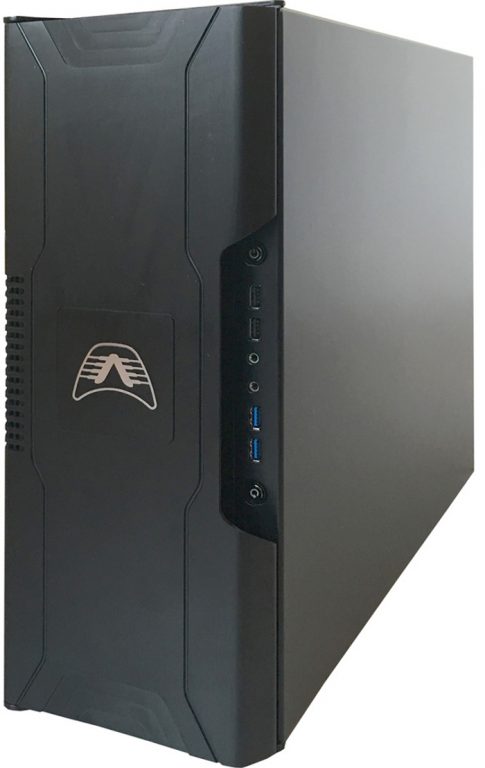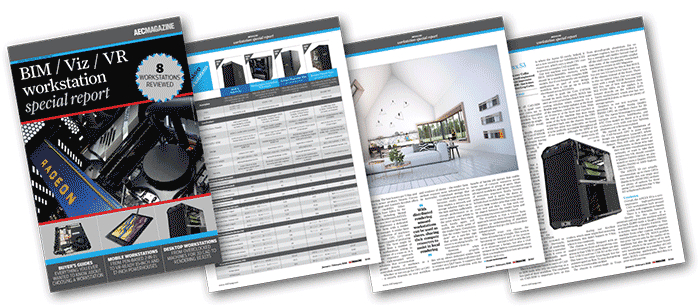This dual Intel Xeon Gold workstation is not only phenomenally fast at ray trace rendering, but with a clock speed of 3.7GHz, also delivers the goods in single-threaded workflows, writes Greg Corke
‘Custom workstation manufacturer’ means different things to different people. There are many firms that simply take off-the-shelf PC components, throw in a professional graphics card and call it a workstation. But there are very few that take customisation to the level that Herts-based Armari does.
Armari is well known for designing its own custom chassis. The slimline VR-focused Magnetar V25 that we reviewed in February 2017, for example, features a dedicated pocket for the HTC Vive link box. But you may not know that the company goes even deeper into customisation, making bespoke components for its workstations, such as PCIe riser boards, heat sinks and PSU cable looms.
In its brand new Magnetar R80 workstation, it is looking to get the most out of two power-hungry Xeon Scalable CPUs by letting them run at full frequency when all cores are being used. Liquid cooling is the obvious answer but while there are many off-the-shelf liquid coolers for consumer CPUs, when it comes to the new Xeon, they simply don’t exist as the volumes are not there. As a result, Armari is developing its own custom liquid cooling system, so the CPUs can run at turbo speed on all cores, rather than just the usual one or two.
Unfortunately, the custom cooling solution is still being manufactured, so Armari sent in a pre-production machine with air cooling instead. This means that instead of the two Intel Xeon Gold 6154 processors running all of their 18 cores at 3.70GHz (which Armari says it will achieve once the custom cooling system is ready), clock speeds on this air-cooled system will be a touch slower. But not that much slower. On test, it managed to maintain around 3.5GHz, even after we had been rendering a complex KeyShot scene for over an hour.
Rendering performance is virtually identical to the dual 32-core AMD Epyc-based Boston workstation. The Magnetar R80 completed the V-Ray benchmark in 21 seconds and our KeyShot test render in 94 seconds.
However, because it attains this level of performance with fewer CPU cores running at a higher frequency, it beats the Boston machine hands-down in a single-threaded race. With a single core clocked at 3.70GHz, it was 32% faster in our SolidWorks IGES export test.
Product specifications
■ 2 x Intel Xeon Gold 6154 (3.0GHz, 3.7GHz Turbo) (18 cores, 36 threads)
■ 192GB (12 x 16GB) DDR4-2666 ECC Registered
■ AMD Radeon Pro WX 9100 (16GB) (17.Q4 driver)
■ 480GB Intel Optane 900P NVMe SSD + 4TB Western Digital Gold SATA-6Gb HDD
■ Supermicro X11DAi-N
■ Microsoft Windows 10 Pro
■ 1 year on-site maintenance contract (2 and 3 year options available)
CPU benchmarks (single threaded) – Seconds (smaller is better)
■ SolidWorks 2015 IGES export: 116
CPU benchmarks (multi-threaded) – Seconds (smaller is better)
■ Luxion KeyShot 6.1 render test:94
■ V-Ray CPU rendering benchmark (CPU): 142
GPU compute benchmark – Seconds (smaller is better)
■ V-Ray render benchmark (GPU): 21
3D graphics benchmarks (3D CAD) – Score (bigger is better)
■ SPECapc for SolidWorks 2015 (shaded + edges): 4.97
■ SPECapc for SolidWorks 2015 (RealView + shadows): 8.78
■ SPECapc for SolidWorks (RealView + shadows + AO): 25.42
■ SPECapc for PTC Creo 3.0 (shaded + edges): N/A
■ SPECapc for PTC Creo 3.0 (reflection): N/A
3D graphics benchmarks (design viz) – Frames Per Second (FPS) (bigger is better)
■ LumenRT (hotel model) (FPS): 14 (17.Q4 driver) 51 (17.Q4.1 driver)
■ LumenRT (roundabout model): 10 (17.Q4 driver) 26 (17.Q4.1 driver)
■ Autodesk LIVE (Villa Enhanced model): 71 (17.Q4 driver) 128 (17.Q4.1 driver)
■ Autodesk VRED Professional (AA off): 60
■ Autodesk VRED Professional (AA medium): 26
■ Autodesk VRED Professional (AA ultra high ): 11
3D graphics benchmarks (VR) – Frames Per Second (FPS) (bigger is better)
■ VR Mark (Orange): 138.16 (17.Q4 driver) 212.6 (17.Q4.1 driver)
■ VR Mark (Blue): 40.24 (17.Q4 driver) 41.34 (17.Q4.1 driver)
■ VR Mark (Cyan): 147.72 (17.Q4 driver) 148.39 (17.Q4.1 driver)
Notably, it was also only 17% slower than the Fujitsu Celsius W570power+, a typical CAD workstation with a quad core Intel Core i7-7700 CPU (3.6GHz up to 4.2GHz) and Nvidia Quadro P4000 GPU.
Keeping clock speeds relatively high also benefits 3D graphics performance in CPU-limited applications like SolidWorks. In shaded-with-edges mode, for example, the machine was only a touch slower than the Fujitsu and is almost certainly powerful enough to handle anything you can throw at it as far as 3D CAD or BIM is concerned.
In GPU-hungry applications like Autodesk VRED Professional, however, it’s the high-end Vega-based AMD Radeon Pro WX 9100 that does all the heavy lifting, delivering solid scores on par with the Quadro P4000-based BOXX Apexx S3.
The combination of 3.70GHz CPU and Radeon Pro WX 9100 GPU also makes this machine capable of powering VR on the HTC Vive or Oculus Rift. In the VRMark benchmark, it excelled in the DirectX 12-based Cyan test, delivering a score over and above the Nvidia Quadro P5000. This is good news for those using the Unreal or Unity game engines for viz or VR as these applications are likely to move to DirectX 12 soon. However, in the Orange Room test, it was slower than we expected, as it was in other DirectX 11 game engine applications, LumenRT and Autodesk Revit Live.
To explore if this was a driver issue, we changed the 17.Q4 driver for 17.Q4.1, the one recommended for the similar AMD Radeon Vega Frontier Edition. Performance immediately rose significantly in Autodesk Revit Live, LumenRT and VRMark Orange Room. However, as 17.Q4.1 is not the recommended driver for the Radeon Pro WX 9100, we would not advocate its use in a professional environment. It looks like
AMD might need to do some driver tweaks here. Interestingly, we did not experience anywhere near the same kind of slowdown when using the Radeon Pro WX 9100 with the 17.Q4 driver on an Intel Core i5-4690K-based workstation, so it may be a chipset issue (the Intel C621 chipset is very new).
In VR itself, it performed well, working perfectly fine in Revit Live, an application the Radeon Pro WX 7100 struggles with. In Autodesk VRED Professional, it could handle all of our test models, but with anti-aliasing enabled we only got a flicker free experience with smaller models.
The Radeon Pro WX 9100 is also well suited to GPU rendering, but it depends on the application. In the V-Ray benchmark, which uses an experimental OpenCL mode, performance was significantly slower than a Quadro P4000. However, in Radeon ProRender, a free GPU OpenCL renderer developed by AMD, it edges out a Quadro P5000.
To boost GPU rendering performance, you can add a double and a single slot GPU. In our test machine, however, it’s limited to a second WX 9100 or two WX 7100s, as the fourth slot is taken by a high performance 480GB Intel Optane 900P PCIe SSD. There’s also a 4TB Western Digital Gold Datacenter HDD for storing the bulk of your data.
The test machine came configured with 192GB of memory, filling 12 out of the 16 DIMM slots with 16GB DDR4-2666 ECC modules to make the most of the Xeon’s six-channel memory architecture.
For a machine with such high computational potential, the chassis is surprisingly small. And despite having to cool two 200W CPUs and a 230W GPU (as well as memory and storage), fan noise is really not too distracting. We imagine it will get even quieter with liquid cooling.
The chassis has some nice touches, such as the long and slender rack server class 1,280W power supply, which pulls out from the rear of the machine, making it very easy to change in case of a failure. There are also two front-loading 2.5-inch drive bays that can be accessed easily.
Overall, the Magnetar R80 looks to be a phenomenal machine for digital artists, offering incredible performance for ray trace rendering without having to sacrifice performance in single-threaded workflows. There’s also a powerful VR capable GPU. And while it looks like there is some work to do in DirectX performance, one must not forget that this is a pre-production machine.
Incredibly, there’s more to come. When Armari starts shipping the machine with liquid cooling (scheduled for Feb 2018) and all core speeds rise to 3.70GHz, it looks destined to set a new AEC Magazine benchmark record for desktop rendering
Price: £11,495 + VAT
This article is part of an AEC Magazine workstation special report. To read articles and reviews in this report click on the links below.
Desktop Workstation Buyer’s Guide
Essential advice for those looking to buy a workstation for product development
Boxx Apexx S3
The overclocked six core ‘Coffee Lake Core i7 CPU makes this CAD workstation fly
Workstation Specialists WS-1160A
AMD CPU and AMD GPU combine for a powerful workstation for CAD,viz and VR
AMD Radeon Vega GPUs
What does AMD’s Vega GPU architecture bring to CAD, VR, viz and GPU rendering?
Boston Venom EPYC (Pre Production Unit)
Dual 32 core AMD Epyc CPUs make this rendering beast fly, but it’s at the expense of single threaded performance
Mobile workstation buyer’s guide
A rundown of the things to look out when buying a professional 3D laptop
Wacom MobileStudio Pro 16
Wacom’s legendary pen technology is embedded in a pro 3D tablet
HP ZBook x2 G4 (Pre-Production Unit)
This detachable 2-in-1 combines Wacom pen technology with a Quadro GPU for 3D CAD
PNY PrevailPro P4000
This slimline 15-inch mobile workstation breaks all the rules by putting a powerful ‘VR Ready’ GPU at its heart
Dell Precision 7720
With powerful processors, impressive cooling, good serviceability and excellent build quality, this 17” mobile workstation is hard to beat
Choosing a workstation? It’s not that straightforward
How to future proof your workstation to support new and emerging product development workflows
Rendering beyond the CAD workstation
When rendering work is on the cards, what’s the best way for a firm to get its machines and its workflows up to speed?
If you enjoyed this article, subscribe to AEC Magazine for FREE







